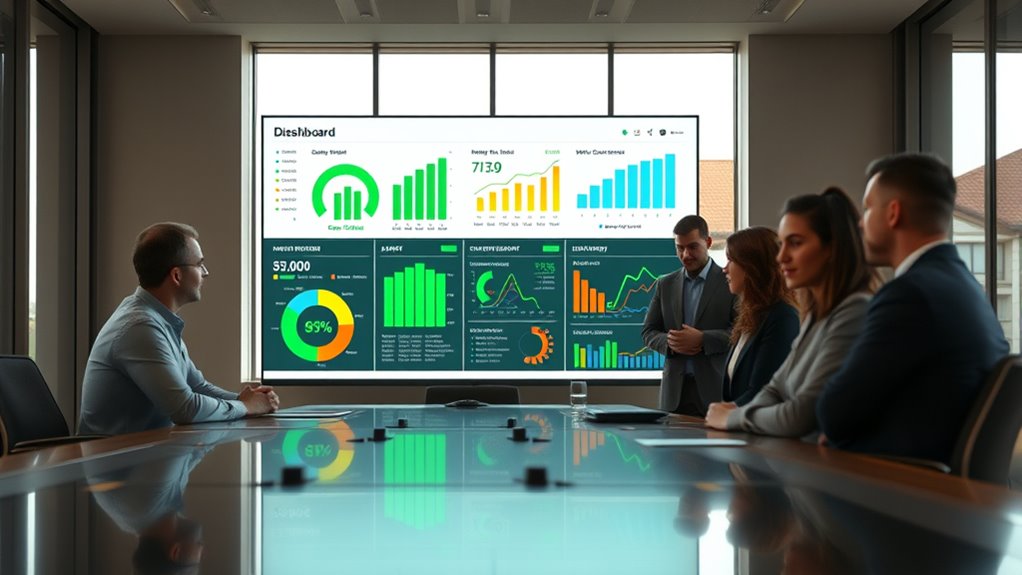Sustainability metrics help you measure the real impact of your environmental, social, and economic actions. By tracking indicators like carbon emissions, water use, waste diversion, and social equity, you gain clear insights into your performance. Setting measurable goals and regularly analyzing data keeps you focused on improvement. Incorporating these metrics into your decision-making guarantees long-term, positive outcomes. To discover how to choose the right metrics and maximize their value, explore further.
Key Takeaways
- Effective sustainability metrics balance environmental, social, and economic indicators to accurately reflect overall impact.
- Setting clear, measurable goals and tracking progress ensures accountability and continuous improvement.
- Integrating metrics into decision-making guides organizations toward sustainable, long-term strategies.
- Transparent reporting of measurable outcomes builds trust with stakeholders and demonstrates real impact.
- Using data-driven insights helps identify strengths, weaknesses, and areas for targeted sustainability actions.

Sustainability metrics are essential tools that help organizations measure and manage their environmental, social, and economic impacts. When you focus on these metrics, you gain a clearer understanding of how your operations affect the planet and society, allowing you to make more informed decisions. Instead of relying on intuition or vague assumptions, you can rely on concrete data that shows where your organization stands and identifies areas for improvement. This transparency not only boosts internal accountability but also builds trust with stakeholders, customers, and investors who increasingly demand sustainable practices.
Sustainability metrics enable organizations to measure impacts, build trust, and make informed, responsible decisions for a sustainable future.
You’ll find that choosing the right metrics is vital. Not all measurements are equally meaningful; some may be easy to track but don’t truly reflect your organization’s sustainability performance. For example, tracking only carbon emissions might overlook other significant impacts like water usage or waste generation. To measure your real impact, you need a balanced set of indicators that encompass various dimensions of sustainability. This might include energy consumption, water efficiency, waste diversion rates, social equity measures, and economic contributions. By monitoring these aspects, you can pinpoint specific areas where you’re excelling or falling short.
Once you’ve identified the relevant metrics, setting clear, achievable targets becomes your next step. These goals give your team direction and motivate continuous improvement. When you regularly collect and analyze data, you can track progress over time, recognizing successes and adjusting strategies as needed. Effective measurement also enables you to communicate your performance transparently, demonstrating accountability to stakeholders and differentiating your organization in a competitive landscape. When stakeholders see measurable progress, they’re more likely to support your sustainability initiatives and invest in your long-term vision.
Incorporating sustainability metrics into your decision-making process ensures that sustainability isn’t an afterthought but a core component of your strategic planning. You’ll avoid making choices that might seem beneficial in the short term but are harmful in the long run. Instead, you’ll prioritize actions that create lasting positive impacts, such as reducing resource consumption or enhancing community well-being. Over time, this disciplined approach helps embed sustainability into your organizational culture, making it a natural part of your operations.
Ultimately, the true power of sustainability metrics lies in their ability to turn abstract concepts into actionable insights. When you measure what matters most, you can demonstrate real impact, drive meaningful change, and position your organization for a more sustainable future. It’s about shifting from guesswork to evidence-based practices that align your business goals with the health of the planet and society. That’s how you guarantee your efforts translate into tangible, lasting results. Incorporating comprehensive sustainability metrics ensures that all relevant factors are considered for a holistic view of your organization’s impact.
Frequently Asked Questions
How Do Sustainability Metrics Vary Across Different Industries?
You’ll notice sustainability metrics differ across industries because each sector faces unique challenges and priorities. For example, manufacturing focuses on reducing emissions and waste, while tech emphasizes energy efficiency and data security. You should tailor metrics to reflect industry-specific impacts, like water use in agriculture or supply chain ethics in fashion. By customizing these metrics, you can accurately measure your progress and demonstrate your commitment to sustainability in your particular field.
What Are the Limitations of Current Sustainability Measurement Methods?
You might find current sustainability measurement methods like trying to capture a flowing river in a jar—limiting and unable to reflect true impact. They often overlook complexities, rely on incomplete data, and focus on short-term results. Biases and inconsistencies also skew the picture, making it hard to see the full landscape. This means your efforts may seem more impactful than they truly are, masking underlying challenges.
How Can Small Businesses Implement Effective Sustainability Metrics?
You can implement effective sustainability metrics by starting with clear, achievable goals tailored to your business. Track key indicators like energy use, waste, and supply chain impacts regularly. Use simple tools or software to gather data consistently. Educate your team on sustainability practices to foster engagement. Review your metrics periodically, and adjust your strategies as needed. This proactive approach helps you demonstrate real impact and continuously improve your sustainability efforts.
What Role Do Government Policies Play in Sustainability Metrics?
Government policies shape your approach to sustainability metrics by setting clear standards and incentives. They create a framework that guides your efforts, ensuring transparency and accountability. Without strong policies, your progress might lack consistency or credibility. But with them, you’re motivated to innovate and measure impact effectively. These policies act as a compass, revealing the true impact of your sustainability initiatives and helping you stay on the right path.
How Is Data Accuracy Ensured in Sustainability Reporting?
You ensure data accuracy in sustainability reporting by implementing rigorous verification processes, such as third-party audits and cross-checking data sources. You also establish clear standards and guidelines for data collection, training staff on proper procedures, and using reliable technology tools to minimize errors. Regular reviews and updates of data practices help identify discrepancies early, ensuring your reports reflect true environmental and social impacts.
Conclusion
By embracing sustainability metrics, you hold the compass that guides your journey toward genuine impact. They’re the lighthouse shining through the fog of ambiguity, illuminating your path to meaningful change. Remember, measuring is the heartbeat of progress—without it, your efforts risk drifting aimlessly. So, harness these tools like a skilled captain steering your ship through turbulent waters, ensuring every step you take leads to a brighter, more sustainable horizon.










